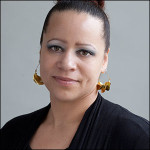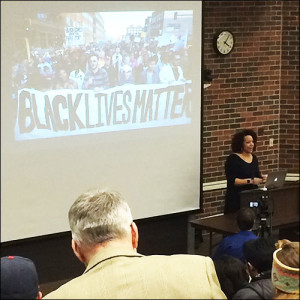Speaker Tells Students to Use Data, Build Trust When Covering Race
Nikole Hannah-Jones Presents Reporting on Race in the Age of Black Lives Matter
By Ashley Szatala
Columbia, Mo. (Feb. 29, 2016) — Throughout the fall semester, Missouri School of Journalism students received more on-the-job learning and training than some journalists gain in a decade.


Demonstrations by Concerned Student 1950, administrative resignations and profiles of courage in the face of racism have been the focus of many articles by the Columbia Missourian, KOMU-TV, KBIA-FM, The New York Times, Washington Post, Los Angeles Times, and many other publications.
This semester, the learning continues as journalism students and faculty further learn how to better report on racial issues by thinking about how to cover race in day-to-day situations, at personal levels, and in every beat.
Two speakers who specialize in covering race – Nikole Hannah-Jones and Jonathan Tilove – will visit MU this semester.
Nikole Hannah-Jones: ‘These Are the Oldest Issues in Our Nation’
Hannah-Jones visited the Missouri School of Journalism on Feb. 9 to discuss covering racial injustice in the age of the Black Lives Matter movement. The School’s Harte Chair in Innovation hosted her trip.
“We are not used to having candid conversations about race,” said Hannah-Jones, an award-winning investigative journalist whose work examines the politics and policies that maintain segregation. “These are the oldest issues in our nation.”

Early in the day, the staffer for The New York Times Magazine talked to more than 70 students in reporting and classes in the print, digital and broadcast emphasis areas. She had lunch with 12 student reporters who covered the campus unrest last fall.
Over pizza, Hannah-Jones talked to the reporters about institutional racism and about being more cognizant of the communities they enter. When an issue arises, reporters can’t just walk into minority communities and expect to easily find the answers they are seeking, Hannah-Jones said. Some people do not trust the media, and she advised the journalists that they need to work to build that trust.
Aaron Reiss, a Missourian sports reporter, was at the luncheon.
“It’s always good to talk about a major issue that we all – whether we know it or not – interact with or participate in some fashion each day,” Reiss said. “I specifically liked when we talked about how to cover race in the future by moving beyond simply the existence at hand and attempting to figure out how to solve it.”
Hannah-Jones read some of the Missourian’s articles on the events on campus last fall, and she told Reiss that she specifically liked the sports story he wrote with fellow Missourian sports reporter Jacob Bogage on the life of a black student athlete.
“She said she had considered pitching a similar story to The New York Times Magazine,” Reiss said. “After she told me that, I bounced some ideas off of her relating to stories I’m currently working on that relate to that one.”
Covering Race During the Black Lives Matter Movement
At 4 p.m., Hannah-Jones spoke to a packed audience in Fisher Auditorium, which was attended by professors, students and members of the public.
“We’re not challenging narratives when our newsrooms aren’t diverse,” Hannah-Jones said. “Twelve percent of newspaper staff are minority.”
She quoted David J. Leonard, a professor of critical culture, gender and race studies at Washington State University, as to why writing about race is so hard.
“The problem with writing about racism is that racism gets reduced to intent, as if intent is all that matters,” Hannah-Jones said.
She explained to the audience how digital platforms have changed the way minorities are covered in the news.
Citizen journalists forced the media to change the way they cover events, Hannah-Jones said. “It was not a believable story to those who didn’t have those experiences.”
She points out that two women started the hashtag #blacklivesmatter after the acquittal of George Zimmerman for fatally shooting the black teen Trayvon Martin. Now there are more than 20 community chapters based around the hashtag throughout the U.S.
During the presentation, Hannah-Jones shared maps of Tuscaloosa, Alabama, based on data showing how poor black students were segregated from more wealthy white students. Then, she showed the data to school officials and asked school officials what the reason was for the segregation. She did a similar comparison to Ferguson schools and then took it to the state head of education. Her data left the officials without a reasonable response.
Senior Kevin Modeleski attended her presentation. “I realize how important it is to include as much data as possible in stories about race,” he said. “The way Nikole used it literally changed her sources’ perspectives on race issues. That’s something that intrigued me the most.”
Hannah-Jones recommended reporting about racial inequality the same way a journalist would cover any other beat.
“I think you can really push your understanding of what’s going on in your campus (by doing this),” Hannah-Jones said.
Up Next: Jonathan Tilove
A second speaker, Jonathan Tilove, will present April 11 and 12 to the Missouri School of Journalism on the craft of covering race.
Tilove, now chief political reporter for the Austin American Statesman in Texas, spent 18 years covering race and immigration issues for Newhouse News Service. While at Newhouse, he and freelance photographer Michael Falco spent two years walking dozens of the Martin Luther King Boulevards thread through the nation. Their six-part series became the basis for a book: “Along Martin Luther King: Travels on Black America’s Main Street.”
Tilove, a three-time winner of the National Headliner Award, will discuss the challenges and imperatives faced by white journalists covering black America. The Knight Chair in Editing is hosting his visit.
Updated: September 15, 2020